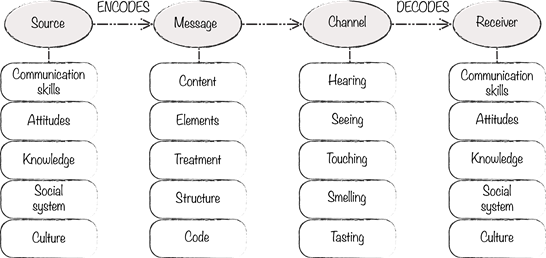Want to be an active listener? Six techniques to master

Have you ever had to tell the same person, the same exact thing, more than once? Annoying isn’t it? And a waste of everyone’s time. We all have a strong desire to feel listened to and understood. And when we don’t feel like our point-of-view is being heard, we can quickly become frustrated, despondent, or even angry.
Effective communication is a two-sided coin. What good is cheese without crackers? What is bread without butter? What is the good of explaining something to someone who is not listening? The answer is not much! As Frank Sinatra once said; they (speaking and listening) go together like a ‘horse and carriage.’
The ability to communicate is the very lifeblood of business relationships. Many of the problems we end up dealing with as Managers stem from poor communication. And often that is in the listening side of the coin.
 Berlo’s SMCR Model of Communication:
Berlo’s SMCR Model of Communication:
In 1960, David Berlo postulated a Sender-Message-Channel-Receiver (SMCR) model of communication. For any communication process to succeed, there is a need for all the elements (sender, message, channel and receiver) to function properly and align together.
Which is why, active listening plays a very important role in determining the success of the communication process. Unless the receiver fully understands the message that is being communicated, he cannot provide feedback, and the process cannot be completed. The stress, therefore, relies on the sender to take responsibility for what the receiver has understood and not just the accuracy of their broadcast as well as on the receiver to use active listening skills to ensure that the message that is being received is accurately and completely understood as it was intended to mean in the first place.
There are numerous benefits of effective listening. And in workplace active listening is imperative. Effective listening breeds trust among employees, superiors, colleagues, subordinates and with every stakeholder. Proper listening forges better relationship and enhances workplace productivity. Proactive listening lessens the stress in our working life, we worry less when we are clearer about expectation, goals and tasks, because now you know for sure; no more guesswork.
As Stephen Covey said in The Seven Habits of Highly Successful People, “Seek first to understand. Then to be understood.”
Listening is generally split into two type Active and Passive.
It is therefore worth considering the difference between passive listening and active listening.
Passive listening is not a bad form of listening, if it is done well. We are not talking about ignoring the other person. You are still paying attention, thinking and remembering. To be effective with passive listening we still need to listen with the intent of understanding, with an open mind, even if we are attending a video presentation, we want to learn, we want to absorb. You are still engaged, and you communicate this engagement through slight facial expressions, sub-conscious body language and non-committal words. You face the speaker, make eye contact, lean in toward the speaker, have an open, relaxed posture, nod or shake your head. Passive listening involves quietly taking in information with only a little outward reaction. Non-committal words are sometimes used such as “Hmm,” “I see,” “Interesting,” “Oh yeah,” and so on. It is a one-way form of communication, wherein there is no significant exchange involved by the two parties.
Passive listening can be a challenge, partly because our minds can move faster than any speakers mouth, so it is quite possible that our mind may drift from the topic of discussion every now and then. Worse – what we are listening to might be relegated to mere background noise, a bit like Baroque Music played during a meal – you do hear the sounds, you do absorb them it is just that you are not trying to make sense out of what you hear. The real risk with passive listening is it is in one ear and out the other, while our minds are actually thinking about other things – or horror of horrors you are listening “From A Point of View” – you’ve already decided what it all means and non-consciously filter what is being said, letting only the words that agree with your point of view through and screening out the rest – No surely not? Yes, most of us do this.
So, what is Active Listening?
With this form of listening the intention not only to understand to what is being said, it is also to question or debate the topic in a two-way conversation that provides space for two, or more people to think out loud, to take the original statements further.
Active listening requires you to “get inside” the speaker’s head so that you can understand the communication from their point of view. As an active listener, you work to understand what the speaker wants to communicate rather than what you want to understand.
You listen objectively without judging content. You take responsibility for completeness of understanding. You do whatever is necessary to get the full intended meaning from the speaker’s communication.
There are two main skills involved in active listening: perception checking and paraphrasing.
1. Perception checking involves figuring out how the speaker is feeling based on what they have told you and what you have seen. This involves you asking questions about what they said – Questions could be used to explore further what has been reported to seek an understanding, to clarify any doubts, or to build on what the speaker has said. Providing the subject of your question is linked explicitly to the theme of what the speaker has told you, then they will consider you have been listening and are taking an active interest in their ideas – always a good move when it comes to empathy!
2. Paraphrasing and summarising is telling the speaker what they have said but in your own words. Again, this allows you to check that you understand and also ensures the speaker that they are being understood. If your paraphrase doesn’t sound quite right to the speaker, they then have the opportunity to clarify. Sometimes it’s also helpful for the speaker to hear what they have said by increasing their own understanding of the situation.
The active listener uses phrases such as “What I hear you saying is. . . . “, or “Do you mean . . . ?”
‘It is better to be understood a little than to be misunderstood a lot’ (Anatole France).
You don’t want to be contrived in trying to gain a better understanding by clinically planning questions that seem to care little about the person. It is better to have given thought to the general direction of your questions so when you ask them it feels like they fit together, flow naturally, show respect and have a purpose. That has surely got to be more effective than to ramble through a conversation aimlessly which achieves very little and / or shows disrespect to the other person.
So here are the top six listening techniques to mater
- Defer Judgment, withhold judgment. Effective listening requires an open mind. Even when good listeners have strong views, they suspend judgment, hold their criticism and they are definitely not mentally preparing a rebuttal the moment the other person starts talking!
- Pay attention actively, show you are listening visually – eye contact, smile, nod and make the “I am listening noises” even repeat one or two short words they’ve used, in your head if not out loud.
- Let the other person finish speaking – Apply the two second rule. It is rude to stop the speaker mid-sentence and ask questions or worse finish their sentence for them. Count two seconds after their last word before you reply.
- Taking notes aids the listening process, allows you to summarise and clarify understanding, along with demonstrating to the other person that they are being heard and that you are ‘pursuing’ that understanding.
- Check your perception – ask open questions, get them to elaborate
- Paraphrase and Summarise – feed back to them your understanding to complete the encoding – decoding loop as per Berlo’s SMCR model.
In Summary:
In order to respect the speaker when they are speaking, do not interrupt, and save your questions or comments till the end. A person who can listen proactively not only makes a great communicator, but also has better relationships with others.
If you want to know more about effective communication – contact me here
For more information please send a message via the Contact Us Page. Or you can register for an upcoming webinar.


